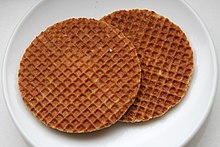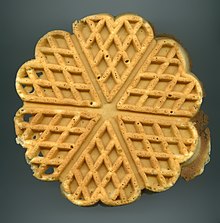waffle

In their simplest form ( wafer ), waffles are flat pastries made from flour and water that are baked between two hot irons ( waffle irons ). In Austria, the diminutive referred Wafer only the industrially produced Neapolitan Wafer .
There are numerous variations of waffles with different shapes and recipes. There are soft and crispy wafers based on different recipes for the wafer mass. In terms of shape, a distinction is made primarily between flat and hollow wafers. Examples of hollow wafers are wafers in the shape of a bowl, in a cylindrical roll shape or in a conical cone shape (including so-called waffle cones , hips and hollow sticks ). Waffle bowls are used in particular as edible disposable tableware for out-of-home sales in ice cream parlors and at ecologically oriented events. In some fish shops, tartar sauce or other dips are served e.g. B. served with fish and chips in waffle bowls.
There is also a wide range of common serving options in terms of consumption or enjoyment. Popular variants are sprinkling with powdered or icing sugar or serving with whipped cream . Strawberries or sour cherries are often served as a hot compote with fresh waffles. Waffles are the most common accompaniment to ice cream , which is often offered in cone-shaped waffles.
term
In the German dictionary of the Brothers Grimm it says: “The waffle is an ancient Lower Franconian festive and fasting pastry, similar to the donuts , strauben etc. In other German regions, brought to France by the Franks , gradually becoming more widespread in Germany from the Rhine region. They now tend to be baked at festivities, at fairs, in houses on special occasions ”. According to Grimm, the word wafel has been used in Dutch since the 15th century, in Germany it has only been known since the 17th century.
Today's etymologists also assume the Dutch origin of the word waffle . In some cases there is a connection with the honeycomb due to the embossing of the waffle iron , but a derivation from the Dutch term for weaving is also assumed, so that waffle originally also meant "fabric".
General
In addition to the thick, soft, rectangular Brussels waffles with their characteristic deep engraving pattern, which are often commercially (e.g. at fairs) or in supermarkets, baking devices for round, flat or segmental heart-shaped soft wafer shapes are also available in stores for use in the private sector. Waffles made in traditional pincer waffle irons are also called Eiserkuchen or Hippen in some places . There are many other regional names, such as Klemmkuchen , Krüllkuchen or New Year's croissant .
Due to the recipe, soft wafers have a distinctive taste of their own, even without additives such as powdered sugar, cream or fruit. Wafer-like wafers, on the other hand, are dry and rather tasteless, so they can either be used as a side dish or decoration for ice cream desserts or processed into cream-filled end products such as wafer slices.
Wafer biscuits are handcrafted using waffle irons or industrially on gas or electrically heated automatic wafer baking machines or waffle baking systems. In machine production, pairs of engraved baking plates connected to form a chain and passing through an oven perform the function of waffle irons.
The crispness of waffles is determined by several factors:
- the content or lack of flour proteins that lead to a “rubbery” result: pure wheat starch or flours with a low gluten content added to (or used exclusively) in the dough reduce the gluten content in the total flour ratio .
- The water content: The sugar contained in the dough can only brown at temperatures around 150 ° C (see also under Caramel and Maillard reaction as well as under Hippe ), which is a condition that there is no water (otherwise the heat energy is "used up" when the water evaporates "Or required). For dehydration during the baking process, a layer that is as thin as possible, obtained by pressing, and a long baking time are necessary; After baking, the product can only dry out (to reduce the water content of the wheat gluten content) if it is not stacked in layers on top of one another, but can be left to cool individually on a wire rack.
- in the dough (added fats, fat content of egg yolks ) or the fats or cooking oil contained in the baking pan can act as "plasticizers" (see also the influence of raw materials on the hip mass ).
History and dissemination
The oldest evidence of waffle irons dates back to the 9th century and was found in Belgium and France . It is believed that the making of wafers in the monasteries was a forerunner of waffle baking. In France there was already a separate guild of waffle bakers in the 13th century . Hollow sticks were known by the 15th century at the latest. At that time, waffles were widespread in the Netherlands , as well as in northern Germany , in Fläming , in Brandenburg and in the Baden area . In southern Germany and Austria , on the other hand, waffles were never part of the folk pastries, but were reserved for upscale cuisine. The Neapolitan waffles are particularly well-known from Austria . Because of their decorative shape, waffles were a popular holiday pastry , and regionally they were traditionally baked for the New Year .
A regional specialty in the Bergisches Land are the Bergische Waffeln (heart waffles ). The waffle baking tradition in Westphalia can be traced back to the 16th century. In Saarland and the Palatinate , cinnamon waffles are traditionally a popular pastry during the Christmas season. They are produced there both commercially and in households. In many places in Belgium there are small shops or stands where fresh Brussels or Liège waffles are baked. The latter consist of a yeast dough with granulated sugar. In the Netherlands, thin pairs of waffles ( stroopwafels ) filled with syrup or honey are very common.
In Sweden, waffles are traditionally baked in a heart shape. March 25th is the official Waffle Day (Våffeldagen in Swedish). In Norway, two special waffle baked goods are part of the Christmas tradition: Goro and Hohlhippen , which are called Krumkake there. There are special waffle irons for both. But waffles also play a very important role as classic pastries with coffee in everyday Norwegian life. The waffles are usually served with typical Norwegian brown cheese or sour cream and strawberry jam. In addition, waffles are often used as hot dog rolls in football stadiums .
literature
- Andrea Jungbluth-Zehnpfennig: Invitation to the Bergisch coffee table. Drinking coffee “with everything dröm on draan” . Gaasterland-Verlag, Düsseldorf 2009, ISBN 978-3-935873-35-2
- Wilhelm Meyer zu Venne: The world of the waffle: From the origins to industrial production. 2nd Edition. ISBN 978-3-8423-8444-6
Web links
Individual evidence
- ↑ waffle. In: Jacob Grimm , Wilhelm Grimm (Hrsg.): German dictionary . tape 27 : W – way [twittering] -zwiesel - (XIII). S. Hirzel, Leipzig 1922 ( woerterbuchnetz.de ).
- ↑ Irene Krauss : Chronicle of beautiful baked goods . Matthaes 1999, ISBN 978-3-87516-292-9 , p. 199.
- ↑ Irene Krauss: Chronicle of beautiful baked goods . Matthaes 1999, ISBN 978-3-87516-292-9 , p. 196 ff.
- ↑ Background information on Waffle Day in Sweden

